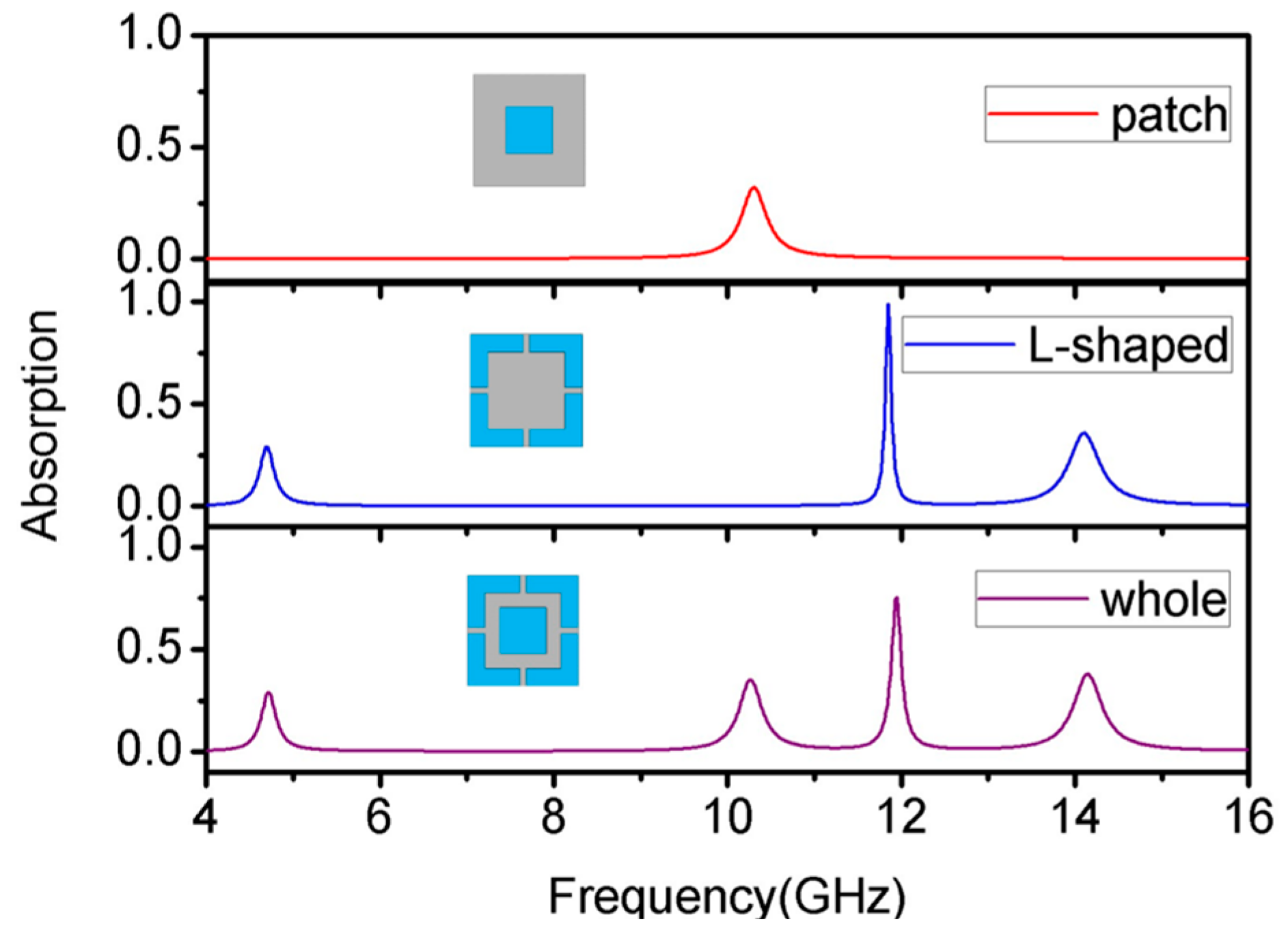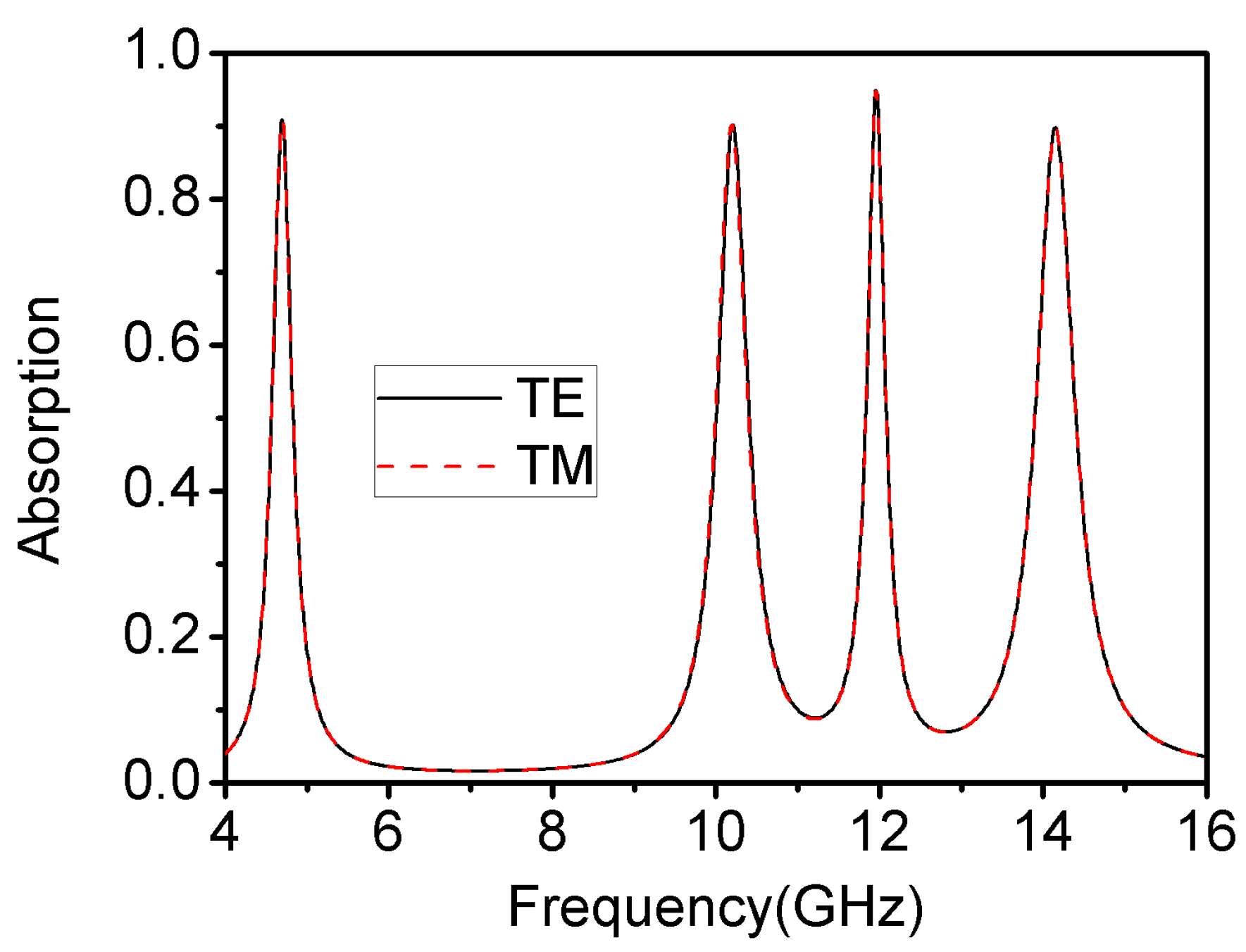A Quad-Band and Polarization-Insensitive Metamaterial Absorber with a Low Profile Based on Graphene-Assembled Film
Abstract
1. Introduction
2. Characterization of Graphene-Assembled Film
3. Methods
4. Results and Discussion
5. Conclusions
Author Contributions
Funding
Institutional Review Board Statement
Informed Consent Statement
Data Availability Statement
Conflicts of Interest
References
- Liu, Y.; Zhang, X. Metamaterials: A New Frontier of Science and Technology. Chem. Soc. Rev. 2011, 40, 2494–2507. [Google Scholar] [CrossRef] [PubMed]
- Veselago, V.G. The Electrodynamics of Substances with Simultaneously Negative Values of ε and μ. Phys.-Uspekhi 1968, 10, 509–514. [Google Scholar] [CrossRef]
- Pendry, J.B.; Holden, A.J.; Stewart, W.J.; Youngs, I. Extremely Low Frequency Plasmons in Metallic Mesostructures. Phys. Rev. Lett. 1996, 76, 4773–4776. [Google Scholar] [CrossRef]
- Pendry, J.B.; Holden, A.J.; Robbins, D.J.; Stewart, W.J. Magnetism from Conductors and Enhanced Nonlinear Phenomena. IEEE T. Microw. Theory 1999, 47, 2075–2084. [Google Scholar] [CrossRef]
- Bui, T.S.; Dao, T.D.; Dang, L.H.; Vu, L.D.; Ohi, A.; Nabatame, T.; Lee, Y.P.; Nagao, T.; Hoang, C.V. Metamaterial-enhanced Vibrational Absorption Spectroscopy for the Detection of Protein Molecules. Sci. Rep. 2016, 6, 32123. [Google Scholar] [CrossRef] [PubMed]
- Cao, Y.; Ruan, C.; Chen, K.; Zhang, X. Research on a High-Sensitivity Asymmetric Metamaterial Structure and its Application as Microwave Sensor. Sci. Rep. 2022, 12, 1255. [Google Scholar] [CrossRef]
- Porter, R. Plate Arrays as a Perfectly-Transmitting Negative-Refraction Metamaterial. Wave Motion 2020, 100, 102673. [Google Scholar] [CrossRef]
- Yang, J.; Chen, S.T.; Chen, M.; Ke, J.C.; Cui, T.J. Folded Transmitarray Antenna with Circular Polarization Based on Metasurface. IEEE T. Antenn. Propag. 2020, 69, 806–814. [Google Scholar] [CrossRef]
- Paul, R.W.; James, L.S.; Alexander, V.K.; Vladimir, M.S.; Vladimir, V.S.; Friedrich, S.; Yuri, A.Z.; Robert, K.D.; Robert, B. All-Dielectric Subwavelength Metasurface Focusing Lens. Opt. Express. 2014, 22, 26212–26221. [Google Scholar] [CrossRef]
- Khorasaninejad, M.; Shi, Z.; Zhu, A.Y.; Chen, W.T.; Sanjeev, V.; Zaidi, A.; Capasso, F. Achromatic Metalens over 60 nm Bandwidth in the Visible and Metalens with Reverse Chromatic Dispersion. Nano Lett. 2017, 17, 1819–1824. [Google Scholar] [CrossRef] [PubMed]
- Huang, L.L.; Zhang, S.; Thomas, Z. Metasurface Holography: From Fundamentals to Applications. Nanophotonics. 2018, 7, 1169–1190. [Google Scholar] [CrossRef]
- Kim, J.; Yang, Y.H.; Badloe, T.; Kim, I.; Yoon, G.; Rho, J. Geometric and Physical Configurations of Meta-atoms for Advanced Metasurface Holography. InfoMat 2021, 3, 739–754. [Google Scholar] [CrossRef]
- Sui, S.; Ma, H.; Wang, J.F.; Pang, Y.Q.; Feng, M.; Xu, Z.; Qu, S.B. Absorptive Coding Metasurface for Further Radar Cross Section Reduction. J. Phys. D Appl. Phys. 2018, 51, 065603. [Google Scholar] [CrossRef]
- Dong, G.; Zhu, S.; He, Y.; Xia, S.; Zhang, A.; Wei, X.; Xu, Z. Radar Cross Section Reduction Metasurface Based on Random Phase Gradients. Appl. Phys. B. 2018, 124, 222. [Google Scholar] [CrossRef]
- Cui, T.J. Electromagnetic Metamaterials: From Effective Media to Field Programmable Systems. Sci. Sin. Inform. 2020, 50, 1427–1461. [Google Scholar] [CrossRef]
- Joy, V.; Dileep, A.; Abhilash, P.V.; Nair, R.U.; Singh, H. Metasurfaces for Stealth Applications: A Comprehensive Review. J. Electron. Mater. 2021, 50, 3129–3148. [Google Scholar] [CrossRef]
- Landy, N.I.; Sajuyigbe, S.; Mock, J.J.; Smith, D.R.; Padilla, W.J. Perfect Metamaterial Absorber. Phys. Rev. Lett. 2008, 100, 279–282. [Google Scholar] [CrossRef]
- Cai, Y.; Guo, Y.; Zhou, Y.G.; Huang, X.; Yang, G.; Zhu, J. Tunable Dual-band Terahertz Absorber with All-dielectric Configuration Based on Graphene. Opt. Express. 2020, 28, 31524–31534. [Google Scholar] [CrossRef]
- Yu, K.; Shen, P.; Zhang, W.; Xiong, X.; Zhang, J.; Liu, Y. A Simple Structure for an Independently Tunable Infrared Absorber Based on a Non-Concentric Graphene Nanodisk. Materials 2022, 15, 2296. [Google Scholar] [CrossRef] [PubMed]
- Muthukrishnan, K.; Narasimhan, V. An Ultra-Thin Triple-Band Polarization-Independent Wide-Angle Microwave Metamaterial Absorber. Plasmonics 2019, 14, 1983–1991. [Google Scholar] [CrossRef]
- Sarkhel, A.; Bhadra, S.R. Compact Quad-Band Polarization-Insensitive Ultrathin Metamaterial Absorber with Wide Angle Stability. IEEE Antenn. Wirel. Pr. 2017, 16, 3240–3244. [Google Scholar] [CrossRef]
- Han, X.; Zhang, Z.; Qu, X. A Novel Miniaturized Tri-band Metamaterial THz Absorber with Angular and Polarization Stability. Optik 2021, 228, 166086. [Google Scholar] [CrossRef]
- Cheng, R.; Zhou, Y.; Wei, R.; Liu, J.; Liu, H.; Zhou, X.; Cai, M.; Pan, X. Doubling and Tripling the Absorption Peaks of a Multi-band Graphene Terahertz Absorber. Diam. Relat. Mater. 2022, 128, 109260. [Google Scholar] [CrossRef]
- Hoque, A.; Tariqul Islam, M.; Almutairi, A.F.; Alam, T.; Jit Singh, M.; Amin, N. A polarization independent quasi-TEM metamaterial absorber for X and Ku band sensing applications. Sensors 2018, 18, 4209. [Google Scholar] [CrossRef] [PubMed]
- Moniruzzaman, M.; Islam, M.; Islam, M.; Chowdhury, E.; Rmili, H.; Samsuzzaman, M. Cross coupled interlinked split ring resonator-based epsilon negative metamaterial with high effective medium ratio for multiband satellite and radar communications. Results Phys. 2020, 18, 103296. [Google Scholar] [CrossRef]
- Zu, H.; Wu, B.; Zhang, Y.; Zhao, Y.; Song, R.; He, D. Circularly Polarized Wearable Antenna with Low Profile and Low Specific Absorption Rate Using Highly Conductive Graphene Film. IEEE Antenn. Wirel. Pr. 2020, 19, 2354–2358. [Google Scholar] [CrossRef]
- Jiang, S.; Song, R.; Hu, Z.; Xin, Y.; Huang, G.; He, D. Millimeter Wave Phased Array Antenna Based on Highly Conductive Graphene-assembled Film for 5G Applications. Carbon 2022, 196, 493–498. [Google Scholar] [CrossRef]
- Liu, X.; Song, R.; Fu, H.; Zhu, W.; Xiao, Y.; Zhang, B.; Wang, S.; He, D. Anti-High-Power Microwave RFID Tag Based on Highly Thermal Conductive Graphene Films. Materials 2023, 16, 093370. [Google Scholar] [CrossRef]
- Hui, Y.; Zu, H.; Song, R.; Fu, H.; Luo, K.; Tian, C.; Wu, B.; Huang, G.; Kou, Z.; Cheng, X.; et al. Graphene-assembled Film-based Reconfigurable Filtering Antenna with Enhanced Corrosion-resistance. Crystals 2023, 13, 747. [Google Scholar] [CrossRef]
- Song, R.; Mao, B.; Wang, Z.; Hui, Y.; Zhang, N.; Fang, R.; Zhang, J.; Wu, Y.; Ge, Q.; Kostya, S.; et al. Comparison of Copper and Graphene-Assembled Films in 5G Wireless Communication and THz Electromagnetic-Interference Shielding. PNAS 2023, 120, 2085160176. [Google Scholar] [CrossRef]
- Fang, S.; Deng, L.; Zhang, P.; Qiu, L.; Xie, H.; Du, J.; Wang, H.; Zhao, H. Dual-band Metamaterial Absorber with Stable Absorption Performance Based on Fractal Structure. J. Phys. D Appl. Phys. 2022, 55, 095003. [Google Scholar] [CrossRef]
- Song, R.; Zhao, X.; Wang, Z.; Fu, H.; Han, K.; Qian, W.; Wang, S.; Shen, J.; Mao, B.; He, D. Sandwiched Graphene Clad Laminate: A Binder-Free Flexible Printed Circuit Broad for 5G Antenna Application. Adv. Eng. Mater. 2020, 22, 2000415. [Google Scholar] [CrossRef]
- Ren, Y.; Ding, J.; Guo, C.; Qu, Y.; Song, Y. Design of a Quad-Band Wide-Angle Microwave Metamaterial Absorber. J. Electron. Mater. 2017, 46, 370–376. [Google Scholar] [CrossRef]
- Edries, M.; Mohamed, H.A.; Hekal, S.S.; El-morsy, M.A.; Mansour, H.A. A New Compact Quad-Band Metamaterial Absorber Using Interlaced I/Square Resonators: Design, Fabrication, and Characterization. IEEE Access 2020, 8, 143723–143733. [Google Scholar] [CrossRef]
- Moniruzzaman, M.; Islam, M.T.; Hossain, I.; Soliman, M.S.; Samsuzzaman, M.; Almalki, S.H. Symmetric Resonator Based Tunable Epsilon Negative Near Zero Index Metamaterial with High Effective Medium Ratio for Multiband Wireless Applications. Sci. Rep. 2021, 11, 21842. [Google Scholar] [CrossRef] [PubMed]
- Hakim, M.L.; Alam, T.; Islam, M.T.; Baharuddin, M.H.; Alzamil, A.; Islam, M.S. Quad-Band Polarization-Insensitive Square Split-Ring Resonator (SSRR) with an Inner Jerusalem Cross Metamaterial Absorber for Ku- and K-Band Sensing Applications. Sensors 2022, 22, 4489. [Google Scholar] [CrossRef]
- The, L.; Hong, T.; Dinh, H.; Xuan, K.; Son, T.; Hong, L.; Anh, D.; Dac, T.; Dinh, L. Dual-Band Isotropic Metamaterial Absorber Based on Near-field Interaction in the Ku band. Curr. Appl. Phys. 2020, 20, 331–336. [Google Scholar] [CrossRef]
- Hannan, S.; Islam, M.T.; Sahar, N.M.; Mat, K.; Chowdhury, M.; Rmili, H. Modified-Segmented Split-Ring Based Polarization and Angle-Insensitive Multi-Band Metamaterial Absorber for X, Ku and K Band Applications. IEEE Access 2020, 8, 144051–144063. [Google Scholar] [CrossRef]
- Hannan, S.; Islam, M.T.; Almutairi, A.F.; Faruque, M.R. Wide Bandwidth Angle- and Polarization-Insensitive Symmetric Metamaterial Absorber for X and Ku Band Applications. Sci. Rep. 2020, 10, 10338. [Google Scholar] [CrossRef]
- Nam, M.H.; Tung, B.S.; Khuyen, B.X.; Ha, D.T.; Ngoc, N.V.; Tran, M.C.; Le, D.T.; Lam, V.D.; Chen, L.; Zheng, H.; et al. Graphene-Integrated Plasmonic Metamaterial for Manipulation of Multi-Band Absorption, Based on Near-Field Coupled Resonators. Crystals 2022, 12, 525. [Google Scholar] [CrossRef]













| Ref. | Thickness (mm) (Corresponding to λ0) | Num. of Absorption Peaks | Frequency (GHz) | Absorption Efficiency | Polarization Insensitivity | Material |
|---|---|---|---|---|---|---|
| [33] | 1.6 (0.036λ0) | 4 | 6.8, 8.24, 11.23, 12.7 | 97%, 95%, 97%, 98% | No | Metal |
| [34] | 1.5 (0.0112λ0) | 4 | 2.248, 2.878, 4.3, 5.872 | 96%, 93%, 93%, 95% | No | Metal |
| [35] | 1.57 (0.022λ0) | 4 | 4.20, 10.14, 13.15, 17.1 | 97.9%, 99.5%, 99.1%, 99.95% | No | Metal |
| [36] | 1.6 (0.066λ0) | 4 | 12.4, 14.11, 17.56, 20.1 | 98.4%, 97.6%, 93%, 96.6 | Yes | Metal |
| [37] | 1.2 (0.0512λ0) | 2 | 12.8, 15.5 | 90.5%, 90.3% | Yes | Metal |
| [38] | 1.58 (0.059λ0) | 4 | 11.23, 14.18, 17.37, 19.18 | 85.5%, 99.13%, 98.19%, 90.8% | Yes | Metal |
| [39] | 1.58 (0.059λ0) | 4 | 11.31, 14.11, 14.23, 17.79 | 94.63%, 95.58%, 97%, 75.58% | Yes | Metal |
| [40] | 1.67 (0.0378λ0) | 3 | 6.80, 8.36, 8.8 | 92.2%, 75%, 70% | Yes | Metal and Graphene ink |
| This work | 0.83 (0.013λ0) | 4 | 4.70, 10.19, 11.96, 14.15 | 90.89%, 90.18%, 94.80%, 90% | Yes | GAF |
Disclaimer/Publisher’s Note: The statements, opinions and data contained in all publications are solely those of the individual author(s) and contributor(s) and not of MDPI and/or the editor(s). MDPI and/or the editor(s) disclaim responsibility for any injury to people or property resulting from any ideas, methods, instructions or products referred to in the content. |
© 2023 by the authors. Licensee MDPI, Basel, Switzerland. This article is an open access article distributed under the terms and conditions of the Creative Commons Attribution (CC BY) license (https://creativecommons.org/licenses/by/4.0/).
Share and Cite
Jin, S.; Zu, H.; Qian, W.; Luo, K.; Xiao, Y.; Song, R.; Xiong, B. A Quad-Band and Polarization-Insensitive Metamaterial Absorber with a Low Profile Based on Graphene-Assembled Film. Materials 2023, 16, 4178. https://doi.org/10.3390/ma16114178
Jin S, Zu H, Qian W, Luo K, Xiao Y, Song R, Xiong B. A Quad-Band and Polarization-Insensitive Metamaterial Absorber with a Low Profile Based on Graphene-Assembled Film. Materials. 2023; 16(11):4178. https://doi.org/10.3390/ma16114178
Chicago/Turabian StyleJin, Shiyi, Haoran Zu, Wei Qian, Kaolin Luo, Yang Xiao, Rongguo Song, and Bo Xiong. 2023. "A Quad-Band and Polarization-Insensitive Metamaterial Absorber with a Low Profile Based on Graphene-Assembled Film" Materials 16, no. 11: 4178. https://doi.org/10.3390/ma16114178
APA StyleJin, S., Zu, H., Qian, W., Luo, K., Xiao, Y., Song, R., & Xiong, B. (2023). A Quad-Band and Polarization-Insensitive Metamaterial Absorber with a Low Profile Based on Graphene-Assembled Film. Materials, 16(11), 4178. https://doi.org/10.3390/ma16114178







